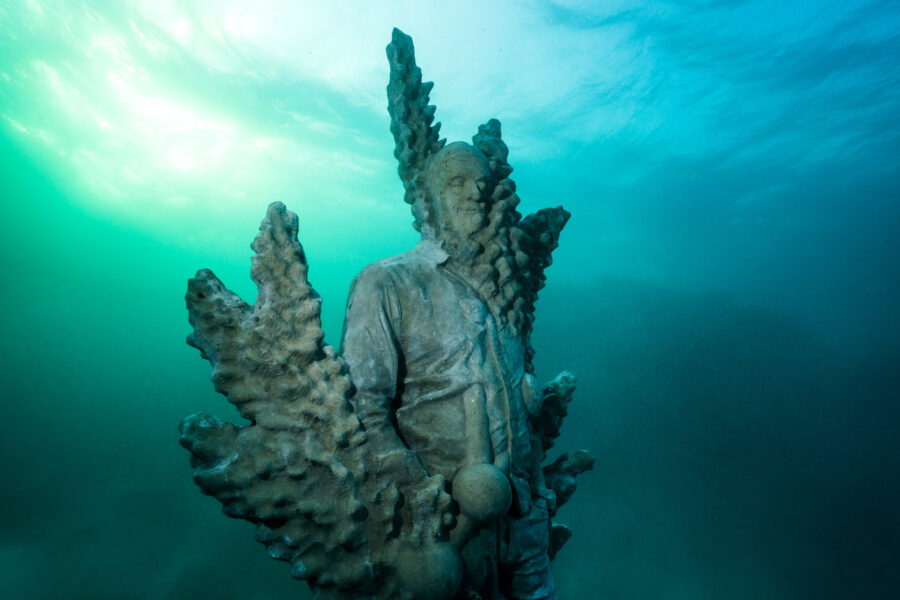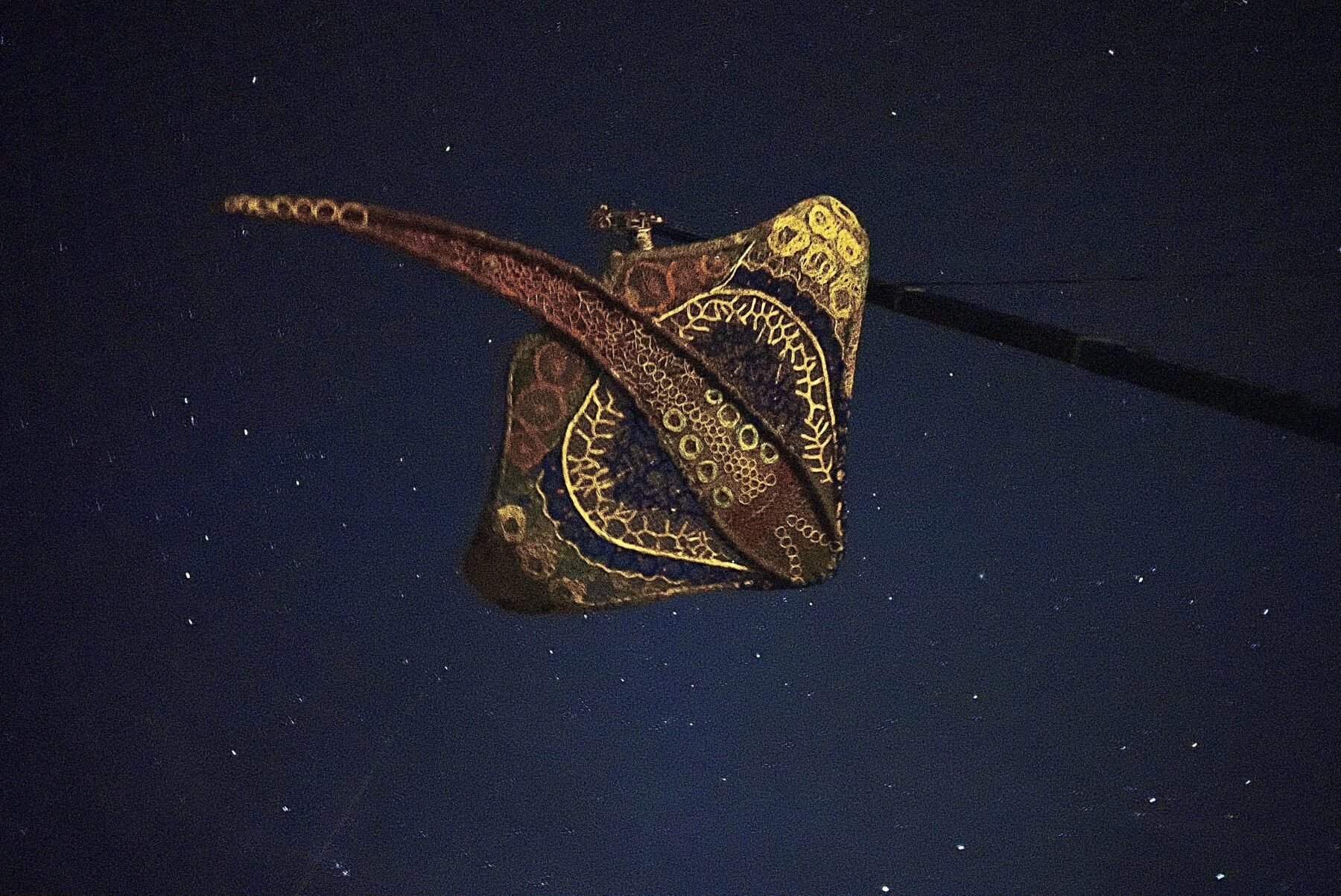June 6, 2023

Ocean Sentinels, MOUA’s newest snorkel trail on the Great Barrier Reef, Qld.
Image credit: Courtesy MOUA
The worlds of science and art are colliding around Australia, and in the doing they’re inspiring climate action, citizen science and a sustainable future. Here’s some of our favourite examples.
Roughly 75km off the coast of Townsville in Queensland is a museum unlike any in the Southern Hemisphere. The artworks here do not hang in a gallery but are submerged underwater and colonised by marine life. Since its founding in 2020, the Museum of Underwater Art (MOUA) has drawn international interest for combining traditional sculpture with reef conservation and restoration.
“There is this preconception that everybody thinks the Great Barrier Reef is dead, so I think it’s really important that people get out and see how incredibly diverse and beautiful it is,” says Jason deCaires Taylor, MOUA founder and sculptor. “We need to get everyone involved in marine conservation. Hopefully it’ll encourage a different type of audience to dive in.”
Ocean Sentinels, MOUA’s newest snorkel trail, was installed over four days in early May. These eight hybrid-form sculptures portray notable scientists and conservationists fused with elements of marine life, and relay stories about their research, heritage or conservation work. The sculptures stand 2.2m tall and are submerged only a few metres below the surface, in shallow waters ideal for snorkellers.
“They form a linear tour,” says Jason. “Each have their own story, so you learn a little bit about the individuals and what they’ve studied.”
Among their ranks are Dr John “Charlie” Veron OAM – the “godfather of corals” who identified 20 per cent of the world’s known coral species – depicted with elements of pectinia and brain corals; Professor Peter Harrison fused with staghorn corals to celebrate his contributions to the field as a “coral IVF” pioneer and discoverer of mass coral spawning on nearby Magnetic Island in 1981; and young Wulgurukaba and Yunbenen woman Jayme Marshall, who is sculpted alongside the roots of mangroves and cathedral fig trees to represent the next generation of Indigenous leaders.
It’s hard to pick a favourite, but Jason says he’s especially fond of Sir Charles Maurice Yonge’s portrait. The marine zoologist led the 1928–29 Great Barrier Reef Expedition that introduced the international scientific community to the reef. His sculpture is blended with a ramose murex shell.
Jason made the sculptures with “green” cement and reinforced them with marine stainless steel – they’re designed to withstand Category 4 cyclones.
But most importantly, the surfaces and shapes of these artworks are designed to attract marine life.
“It’s hoped that in years to come a variety of endemic species such as corals, sponges and hydroids will change the sculptures’ appearance in vibrant and unexpected ways,” says Jason. “Like the Great Barrier Reef itself, they will become a living and evolving part of the ecosystem, emphasising both its fragility and its endurance.”
According to Dr Adam Smith, marine biologist and Deputy Chair of MOUA, colonisation has already begun.
“They’ve already been covered by a sheen of green algae,” Adam says. “As soon as they get put in the water the marine life is attracted to them. Because they’re a structure that acts a bit like an artificial reef, things settle on them; fish seek shelter and over time there will be a natural recruitment of corals.”
Annual monitoring at MOUA’s “Coral Greenhouse” documented a fivefold increase in fish abundance and diversity, compared to baseline surveys at the site.
Divers are encouraged to take photos of marine life and upload them to iNaturalist.
“The key for me is for tourists not only talking about reef conservation and their role in the planet and climate change, but taking action,” Adam says. “A small thing can be to take a photo and upload it for citizen science.”
Adam estimates that more than 500 species have been recorded at John Brewer Reef, 70km off Townsville, from corals, molluscs, sharks, rays and a plethora of fish.
It’s a chilly autumn morning in Sydney, and the usual city rhythm of cars, pedestrians and distant construction is disrupted by drumming and a chorus of singing voices. The music draws the attention of passing commuters, who stop mid-coffee run to watch the performance of the Kerkar Kus dance crew.
The ceremony commemorates the official opening of a new permanent art display in Exchange Square, off the Barangaroo exit of Wynyard train station. Commissioned by Lend Lease and curated by Nina Miall, Mermer Waiskeder: Stories of the Moving Tide features 11 eagle rays handed-crafted from reclaimed ghost nets. The artwork was created by the Ghost Net Collective, a cross-cultural group in north Queensland that has been creating art from discarded, lost or abandoned fishing materials since 2009.
“The net is a silent, deadly killer and we want to raise awareness by people being able to see it,” says Lynnette Griffiths, lead artist of the Ghost Net Collective. “Everyone knows about plastic bottles, but the net is under the water, snagging on reefs and killing our fish. An estimated 80 per cent of plastic pollution in the ocean has its origins in the maritime industries [so] we really need a groundswell of support and awareness.”
The Ghost Net Collective used more than 6.5km of fishing net to create the 11 rays, making it one of the largest hand-crafted public artworks in Australia. Most of the nets were donated by Tangaroa Blue Foundation and Sydney Fish Market, including disused trawler nets taken from Indonesian waters. Despite their steel frames, the sculptures are posed in a way that evoke movement and fluidity, aided by the LED lights that pulse on their bellies.
Lynnette says it took roughly 30 days to stitch the skins onto an individual frame. Each ray is unique, depicted with different motifs of waves, foam and coral. Stitched into the underside of some are smaller rays – more than 100 in total – that were made in online workshops by people across Australia, the Pacific and Canada. Two rays represent Aboriginal Australians and Torres Strait Islanders by featuring the colours of their flags.
Eagle rays are a totem animal on Erub Island in the Torres Strait.
“There’s a connection to these stingrays, which lies in the story of the tidelines,” says Torres Strait artist Jimmy John Thaiday, from Erub Island. “It explains how the tide comes in and the tides go out. In our language it is ‘Mermer Waiskeder’. The ‘Mermer’ is when the tide is coming in, and when the tide is going out. The ‘Waiskeder’, that’s when the tides are starting to change and then you have the sound of the water turning. You hear that when you see all of the waves starting to change.”
Eagle rays were also chosen to represent Barangaroo’s lengthy maritime history, from the Gadigal people fishing in bark canoes to 19th century maritime industries.
“The original tideline for Sydney Harbour was somewhere within this place,” says Lynnette. “When the LEDs are on at night, we’ve denoted the tideline with a bar of light that runs through.”
The fever of eagle rays hangs above one of the most trafficked sites in Sydney’s CBD. They’re best viewed at night, when they come to life in a riot of colours.
Mycelium is taking root in the world of traditional design, with fungal biomaterials harbouring potential to one day displace leather, concrete and fossil fuel-derived plastics.
These possibilities are explored in IM-PERMANENT, a new exhibition in Melbourne that features more than 20 multimodal artworks made entirely from mycelium, including sculpture, apparel, lighting, architectural pieces and more.
“Personal standouts for me include a ceramic wall-cladding material, filled with mycelium and glass fibres, as well as recycled terracotta [that] creates a naturally circular and fire-retardant skin for buildings. It also happens to be stunningly beautiful,” says David Constantine of social impact consultancy Ellis Jones, which created the exhibition in collaboration with RMIT University.
There’s also packaging produced from mycelium. “Think bottle ‘shelves’ for mailing or delivery, packing components and more. Ideas that could turn traditional paper pulp packaging on its head.”
Mycelium is the network of fungal threads – hyphae – that form the “root” of the mushroom. These intricate structures absorb nutrients from the environment and decompose organic matter.
David and his team at Ellis Jones were introduced to mycelium’s potential after a conversation with Ed Linacre, Australia industrial designer and co-founder of Mycelium Studios. David became fascinated by the exceptional work produced by local and international designers.
The unconventional material is compostable and low waste. David describes the biomaterial resource as quickly becoming the “it” material of sustainability. It’s inexpensive, easy to grow, lightweight yet surprisingly strong and durable. As this technology improves, it’s hoped these biomaterials will help achieve a waste-free circular economy.

